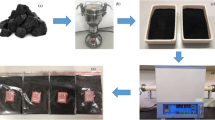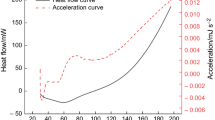Abstract
The coupling disaster of coal spontaneous combustion and methane seriously threatens the safe production of coal mines. In order to study the low-temperature oxidation characteristics of coals oxidized at the methane-containing atmosphere, characteristics of free radicals and thermal effects of two coals oxidized at atmosphere containing different concentrations of CH4 were studied by employing calorimetric and electron spin resonance (ESR) spectrometer experiments. Furthermore, the oxidation characteristics of coals were related to its thermal effect based on the enthalpy changes of active groups’ reactions calculated by Gaussian 16. It was found that CH4 in the oxidation atmosphere could reduce the amount of heat both absorbed and released during the process of low-temperature oxidation. And, the higher the concentration of CH4 in the atmosphere was, the smaller amount of heat absorbed and released. Experimental results of ESR suggested that the concentration, the g-factor, and the linewidth of free radicals were decreased as the concentration of CH4 in the oxidizing atmosphere increased. Analysis of elementary reactions and its corresponding enthalpy change indicated that the reduction of absorbed and released heat resulted by CH4 attributed to the fact that CH4 could block the generation of peroxides and depress the decomposition of the oxygen-containing free radicals. The changes of released carbon monoxide as the function of the concentration of CH4 were in agreement with this indication as well. This study will provide a scientific guidance for the prevention and control of the coupling disasters of coal spontaneous combustion and CH4 and benefit the development of the high-efficiency coal spontaneous combustion inhibitor.





Similar content being viewed by others
References
Xu JP, Gao W, Xie HP, et al. Integrated tech-paradigm based innovative approach towards ecological coal mining. Energy. 2018;151:297–308.
Tang YB. Experimental investigation of applying MgCl2 and phosphates to synergistically inhibit the spontaneous combustion of coal. J Energy Inst. 2017;91(5):639–45.
Bai ZJ, Wang CP, Deng J, et al. Experimental investigation on using ionic liquid to control spontaneous combustion of lignite. Process Saf Environ Prot. 2020;142:138–49.
Xia TQ, Zhou FB, Wang XX, et al. Controlling factors of symbiotic disaster between coal gas and spontaneous combustion in longwall mining gobs. Fuel. 2016;182:886–96.
Zhang YT, Zhang YB, Li YQ, et al. Study on the characteristics of coal spontaneous combustion during the development and decaying processes. Process Saf Environ Prot. 2020;138:9–17.
Spears D, Tewalt S. The geochemistry of environmentally important trace elements in UK coals, with special reference to the Parkgate coal in the Yorkshire-Nottinghamshire Coalfield. Int J Coal Geol. 2009;80:157–66.
Lu W, Guo BL, Qi GS, et al. Experimental study on the effect of preinhibition temperature on the spontaneous combustion of coal based on an MgCl2 solution. Fuel. 2020;265:117032.
Wang CJ, Yang SQ, Li XW. Simulation of the hazard arising from the coupling of gas explosions and spontaneously combustible coal due to the gas drainage of a gob. Process Saf Environ Prot. 2018;118:296–306.
Liu W, Qin YP. Multi-physics coupling model of coal spontaneous combustion in longwall gob area based on moving coordinates. Fuel. 2017;188:553–66.
Zhou FB. Study on the coexistence of gas and coal spontaneous combustion (I): disaster mechanism. J China Coal Soc. 2012;37:843–9.
Xu Q, Yang SQ, Hu XC, et al. Low-temperature oxidation of free radicals and functional groups in coal during the extraction of coalbed methane. Fuel. 2019;239:429–36.
Beamish BB, Jabouri I. Factors affecting hot spot development in bulk coal and associated gas evolution. Australas Inst Min Metall Publ Ser. 2005;2:187–93.
Yang SQ, Qin Y, Sun GW, et al. Research on coupling hazard mechanism of mine gas and coal fire for a gassy and high spontaneous combustion propensity coal seam. J China Coal Soc. 2014;39:1094–101.
Zhu HQ, Liu XK. Theoretical investigation on the relationship between tail roadway methane drainage and distribution of easily spontaneous combustible region in gob. Saf Sci. 2012;50(4):618–23.
Dziurzynski W. Underground fire under conditions of methane inflow. Arch Min Sci. 1991;36:209–25.
Qin BT, Zhang LL, Wang DM, et al. Mechanism and restraining technology on spontaneous combustion of coal detonating gas in goaf. J China Coal Soc. 2009;34:1655–9.
Deng J. Experimental study on explosion characteristics of multi-component combustible gas in goaf. Xuzhou: China University of Mining and Technology; 2007.
Zhang YT, Liu YR, Shi XQ, et al. Risk evaluation of coal spontaneous combustion on the basis of auto-ignition temperature. Fuel. 2018;233:68–76.
Zhao XJ, Wang QS, Xiao HH, et al. Prediction of coal stockpile autoignition delay time using micro-calorimeter technique. Fuel Process Technol. 2013;110:86–93.
Zhong Y, Yang SQ, Hu XC, et al. Whole process inhibition of a composite superabsorbent polymer-based antioxidant on coal spontaneous combustion. Arab J Sci Eng. 2018;43(11):5999–6009.
Lin Q, Wang SG, Liang YT, et al. Analytical prediction of coal spontaneous combustion tendency: velocity range with high possibility of self-ignition. Fuel Process Technol. 2017;159:38–47.
Wang EY, Kong B, Liang JY, et al. Experimental study of electromagnetic radiation during coal heating. J China Univ Min Technol. 2016;45:205–10.
Li ZH, Kong B, Wei AZ, et al. Free radical reaction characteristics of coal low-temperature oxidation and its inhibition method. Environ Sci Pollut Res. 2016;23:23593–605.
Zhong XX, Wang DM, Xu YL, et al. The variation characteristics of free radicals in coal oxidation. J China Coal Soc. 2010;35(6):960–3.
Yuan L, Smith AC. Experimental study on CO and CO2 emissions from spontaneous heating of coals at varying temperatures and O2 concentrations. J Loss Prev Process Ind. 2013;26(6):1321–7.
Zhang ZQ, Kang QN, Yun T, et al. Density functional theory investigation of possible structures of radicals in coal undergoing O2 chemisorption at ambient temperature. Energy Fuels. 2017;31:953–8.
Chen B, Diao ZJ, Lu HY. Using the Reax FF reactive force field for molecular dynamics simulations of the spontaneous combustion of lignite with the Hatcher lignite model. Fuel. 2014;116:7–13.
Gurdal G, Hosgormez H, Ozcan D, et al. The properties of Çan Basin coals (Çanakkale-Turkey): spontaneous combustion and combustion by-products. Int J Coal Geol. 2015;138:1–15.
Dong J, Cheng YP, Jin K, et al. Effects of diffusion and suction negative pressure on coalbed methane extraction and a new measure to increase the methane utilization rate. Fuel. 2017;197:70–81.
Zhang CL, Xu J, Peng SJ, et al. Dynamic evolution of coal reservoir parameters in CBM extraction by parallel boreholes along coal seam. Transp Porous Media. 2018;124(2):325–43.
Wang BX, Jing JS, Chen L. Problems in coal mine safety regulations is the main reason of gas explosion. Fire Sci Technol. 2012;31(01):17–18+45.
Shi XQ, Zhang YT, Chen XK, et al. Numerical study on the oxidation reaction characteristics of coal under temperature-programmed conditions. Fuel Process Technol. 2021;213:106671.
Shi XQ, Zhang YT,Chen XK, et al. Effects of thermal boundary conditions on spontaneous combustion of coal under temperature-programmed conditions. Fuel;120591. (in press).
Sun JH, Sun ZH, Wang QS, et al. Catalytic effects of inorganic acids on the decomposition of ammonium nitrate. J Hazard Mater. 2005;127(1/3):204–10.
Clemens AH, Matheson TW, Rogers DE. Low temperature oxidation studies of dried New Zealand coals. Fuel. 1991;70(2):215–21.
Dai GL. Relation between free radicals concentration and gas products in process of coal low temperature oxidation. J China Coal Soc. 2012;37:122–6.
Wang DM, Xin HH, Qi XY, et al. Mechanism and relationships of elementary reactions in spontaneous combustion of coal: the coal oxidation kinetics theory and application. J China Coal Soc. 2014;39:1667–74.
Mathews J, Chaffee A. The molecular representations of coal—a review. Fuel. 2012;96:1–14.
Kudynska J, Buckmaster H. Low-temperature oxidation kinetics of high-volatile bituminous coal studied by dynamic in situ 9 GHz c.w. e.p.r. spectroscopy. Fuel. 1996;75(7):872–8.
Li JH, Li ZH, Yang YL, et al. Laboratory study on the inhibitory effect of free radical scavenger on coal spontaneous combustion. Fuel Process Technol. 2018;171:350–60.
Huang ZA, Liu XH, Gao YK, et al. Experimental study on the compound system of proanthocyanin and polyethylene glycol to prevent coal spontaneous combustion. Fuel. 2019;254(October 15):115610.
Acknowledgements
The study was supported by National Key R&D Program of China (2018YFC0807900), National Natural Science Foundation of China (Grant Nos. 51974235, 51774233) and Natural Science Foundation of Shaanxi Province (Grant No. 2018JZ5007).
Author information
Authors and Affiliations
Corresponding authors
Additional information
Publisher's Note
Springer Nature remains neutral with regard to jurisdictional claims in published maps and institutional affiliations.
Rights and permissions
About this article
Cite this article
Zhang, Y., Zhang, Y., Li, Y. et al. Low-temperature oxidation characteristics of coals at the methane-containing atmosphere. J Therm Anal Calorim 147, 3379–3389 (2022). https://doi.org/10.1007/s10973-021-10735-0
Received:
Accepted:
Published:
Issue Date:
DOI: https://doi.org/10.1007/s10973-021-10735-0




